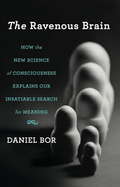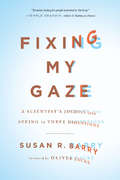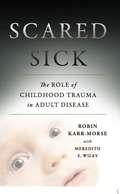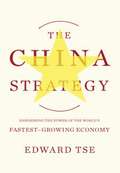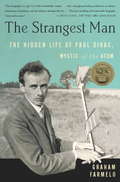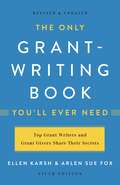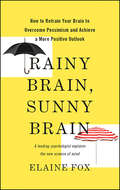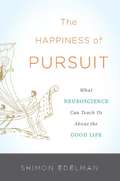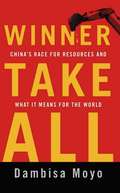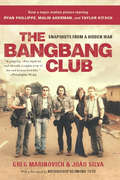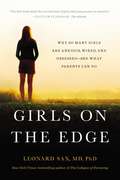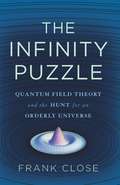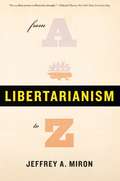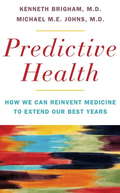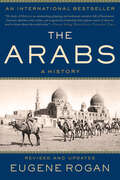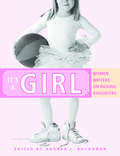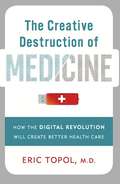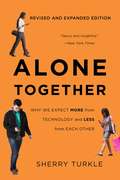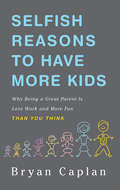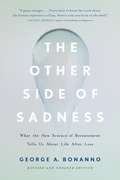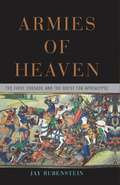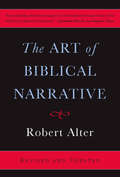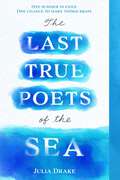- Table View
- List View
The Ravenous Brain: How the New Science of Consciousness Explains Our Insatiable Search for Meaning
by Daniel BorConsciousness is our gateway to experience: it enables us to recognize Van Gogh's starry skies, be enraptured by Beethoven's Fifth, and stand in awe of a snowcapped mountain. Yet consciousness is subjective, personal, and famously difficult to examine: philosophers have for centuries declared this mental entity so mysterious as to be impenetrable to science. In The Ravenous Brain, neuroscientist Daniel Bor departs sharply from this historical view, and builds on the latest research to propose a new model for how consciousness works. Bor argues that this brain-based faculty evolved as an accelerated knowledge gathering tool. Consciousness is effectively an idea factory--that choice mental space dedicated to innovation, a key component of which is the discovery of deep structures within the contents of our awareness. This model explains our brains' ravenous appetite for information--and in particular, its constant search for patterns. Why, for instance, after all our physical needs have been met, do we recreationally solve crossword or Sudoku puzzles? Such behavior may appear biologically wasteful, but, according to Bor, this search for structure can yield immense evolutionary benefits--it led our ancestors to discover fire and farming, pushed modern society to forge ahead in science and technology, and guides each one of us to understand and control the world around us. But the sheer innovative power of human consciousness carries with it the heavy cost of mental fragility. Bor discusses the medical implications of his theory of consciousness, and what it means for the origins and treatment of psychiatric ailments, including attention-deficit disorder, schizophrenia, manic depression, and autism. All mental illnesses, he argues, can be reformulated as disorders of consciousness--a perspective that opens up new avenues of treatment for alleviating mental suffering. A controversial view of consciousness, The Ravenous Brain links cognition to creativity in an ingenious solution to one of science's biggest mysteries.
Fixing My Gaze $ A Scientist's Journey Into Seeing in Three Dimensions: A Scientist's Journey Into Seeing in Three Dimensions
by Susan R. BarryWhen neuroscientist Susan Barry was fifty years old, she took an unforgettable trip to Manhattan. As she emerged from the dim light of the subway into the sunshine, she saw a view of the city that she had witnessed many times in the past but now saw in an astonishingly new way. Skyscrapers on street corners appeared to loom out toward her like the bows of giant ships. Tree branches projected upward and outward, enclosing and commanding palpable volumes of space. Leaves created intricate mosaics in 3D. With each glance, she experienced the deliriously novel sense of immersion in a three dimensional world. Barry had been cross-eyed and stereoblind since early infancy. After half a century of perceiving her surroundings as flat and compressed, on that day she was seeing Manhattan in stereo depth for first time in her life. As a neuroscientist, she understood just how extraordinary this transformation was, not only for herself but for the scientific understanding of the human brain. Scientists have long believed that the brain is malleable only during a “critical period” in early childhood. According to this theory, Barry’s brain had organized itself when she was a baby to avoid double vision – and there was no way to rewire it as an adult. But Barry found an optometrist who prescribed a little-known program of vision therapy; after intensive training, Barry was ultimately able to accomplish what other scientists and even she herself had once considered impossible. A revelatory account of the brain’s capacity for change, Fixing My Gaze describes Barry’s remarkable journey and celebrates the joyous pleasure of our senses.
Scared Sick: The Role of Childhood Trauma in Adult Disease
by Robin Karr-Morse Meredith S. WileyThe first years of human life are more important than we ever realized. InScared Sick, Robin Karr-Morse connects psychology, neurobiology, endocrinology, immunology, and genetics to demonstrate how chronic fear in infancy and early childhood- when we are most helpless-lies at the root of common diseases in adulthood. Compassionate and based on the latest research,Scared Sickwill unveil a major public health crisis. Highlighting case studies and cutting-edge scientific findings, Karr- Morse shows how our innate fight-or-flight system can injure us if overworked in the early stages of life. Persistent stress can trigger diabetes, heart disease, obesity, depression, and addiction later on.
The China Strategy: Harnessing the Power of the World's Fastest-Growing Economy
by Edward TseNo major enterprise or financial institution can avoid doing business with China--if not directly, then through myriad hidden connections. Global businesses either use Chinese resources or sell to and in China or compete with companies that do. <P><P> Because there's no avoiding China, business leaders need a framework that orders the different (and seemingly contradictory) streams of data that hint at its future. That framework is The China Strategy. In this invaluable book, Edward Tse explains the ever-changing nature of China's business environment, its increasingly complex relationship with the rest of the world, and the global business implications--not just for our current environment but for the next decade. Change, Tse argues, is taking place in non-linearly. Some dimensions (like Chinese entrepreneurship) are expanding exponentially, while others (like the value of China's labor arbitrage) may be reaching a plateau. Eschewing easy explanations, Tse shows how to build and execute a global business strategy in light of these changes, offering practical advice amidst a sea of simple books that offer too-quick solutions. In a world in which a successful business strategy means a successful China strategy, this book is uniquely positioned to help business leaders navigate the "country that cannot be ignored. "
The Strangest Man: The Hidden Life of Paul Dirac, Mystic of the Atom
by Graham FarmeloPaul Dirac was among the great scientific geniuses of the modern age. One of the discoverers of quantum mechanics, the most revolutionary theory of the past century, his contributions had a unique insight, eloquence, clarity, and mathematical power. His prediction of antimatter was one of the greatest triumphs in the history of physics. One of Einstein's most admired colleagues, Dirac was in 1933 the youngest theoretician ever to win the Nobel Prize in physics. Dirac's personality is legendary. He was an extraordinarily reserved loner, relentlessly literal-minded and appeared to have no empathy with most people. Yet he was a family man and was intensely loyal to his friends. His tastes in the arts ranged from Beethoven to Cher, from Rembrandt to Mickey Mouse. Based on previously undiscovered archives, The Strangest Man reveals the many facets of Dirac's brilliantly original mind. A compelling human story, The Strangest Man also depicts a spectacularly exciting era in scientific history.
The Only Grant-Writing Book You'll Ever Need
by Ellen Karsh Arlen Sue FoxFrom top experts in the field, the definitive guide to grant-writingWritten by two expert authors who have won millions of dollars in government and foundation grants, this is the essential book on securing grants. It provides comprehensive, step-by-step guide for grant writers, including vital up-to-the minute interviews with grant-makers, policy makers, and nonprofit leaders. This book is a must-read for anyone seeking grants in today's difficult economic climate.The Only Grant-Writing Book You'll Ever Need includes:Concrete suggestions for developing each section of a proposalHands-on exercises that let you practice what you learn A glossary of termsConversations with grant-makers on why they award grants...and why they don'tInsights into how grant-awarding is affected by shifts in the economy
Rainy Brain, Sunny Brain: How to Retrain Your Brain to Overcome Pessimism and Achieve a More Positive Outlook
by Elaine FoxAre you optimistic or pessimistic? Glass half-full or half-empty? Do you look on the bright side or turn towards the dark? These are easy questions for most of us to answer, because our personality types are hard-wired into our brains. As pioneering psychologist and neuroscientist Elaine Fox has discovered, our outlook on life reflects our primal inclination to seek pleasure or avoid danger-inclinations that, in many people, are healthily balanced. But when our “fear brain” or “pleasure brain” is too strong, the results can be disastrous, as those of us suffering from debilitating shyness, addiction, depression, or anxiety know all too well. Luckily, anyone suffering from these afflictions has reason to hope. Stunning breakthroughs in neuroscience show that our brains are more malleable than we ever imagined. InRainy Brain, Sunny Brain, Fox describes a range of techniques-from traditional cognitive behavioral therapy to innovative cognitive-retraining exercises-that can actually alter our brains’ circuitry, strengthening specific thought processes by exercising the neural systems that control them. The implications are enormous: lifelong pessimists can train themselves to think positively and find happiness, while pleasure-seekers inclined toward risky or destructive behavior can take control of their lives. Drawing on her own cutting-edge research, Fox shows how we can retrain our brains to brighten our lives and learn to flourish. With keen insights into how genes, life experiences and cognitive processes interleave together to make us who we are,Rainy Brain, SunnyBrainrevolutionizes our basic concept of individuality. We learn that we can influence our own personalities, and that our lives are only as “sunny” or as “rainy” as we allow them to be.
The Happiness of Pursuit: What Neuroscience Can Teach Us About the Good Life
by Shimon EdelmanWhen fishing for happiness, catch and release. Remember these seven words-they are the keys to being happy. So says Shimon Edelman, an expert on psychology and the mind. In The Happiness of Pursuit, Edelman offers a fundamental understanding of pleasure and joy via the brain. Using the concept of the mind as a computing device, he unpacks how the human brain is highly active, involved in patterned networks, and constantly learning from experience. As our brains predict the future through pursuit of experience, we are rewarded both in real time and in the long run. Essentially, as Edelman discovers, it’s the journey, rather than the destination, that matters. The idea that cognition is computation-the brain is a machine-is nothing new of course. But, as Edelman argues, the mind is actually a bundle of ongoing computations, essentially, the brain being one of many possible substrates that can support them. Edelman makes the case for these claims by constructing a conceptual toolbox that offers readers a glimpse of the computations underlying the mind’s faculties: perception, motivation and emotions, action, memory, thinking, social cognition, learning and language. It is this collection of tools that enables us to discover how and why happiness happens. An informative, accessible, and witty tour of the mind, The Happiness of Pursuit offers insights to a thorough understanding of what minds are, how they relate to each other and to the world, and how we can make the best of it all.
Winner Take All: China's Race for Resources and What It Means for the World
by Dambisa MoyoCommodities permeate virtually every aspect of modern daily living, but for all their importance-their breadth, their depth, their intricacies, and their central role in daily life-few people who are not economists or traders know how commodity markets work. Almost every day, newspaper headlines and media commentators scream warnings of impending doom--shortages of arable land, clashes over water, and political conflict as global demand for fossil fuels outstrips supply. The picture is bleak, but our grasp of the details and the macro shifts in commodities markets remain blurry. Winner Take All is about the commodity dynamics that the world will face over the next several decades. In particular, it is about the implications of China’s rush for resources across all regions of the world. The scale of China’s resource campaign for hard commodities (metals and minerals) and soft commodities (timber and food) is among the largest in history. To be sure, China is not the first country to launch a global crusade to secure resources. From Britain’s transcontinental operations dating back to the end of the 16th century, to the rise of modern European and American transnational corporations between the mid 1860’s and 1870’s, the industrial revolution that powered these economies created a voracious demand for raw materials and created the need to go far beyond their native countries. So too is China’s resource rush today. Although still in its early stages, already the breadth of China’s operation is awesome, and seemingly unstoppable. China’s global charge for commodities is a story of China’s quest to secure its claims on resource assets, and to guarantee the flow of inputs needed to continue to drive economic development. Moyo, an expert in global commodities markets, explains the implications of China’s resource grab in a world of diminishing resources.
The Bang-Bang Club: Snapshots From a Hidden War
by Greg Marinovich Joao Silva Archbishop Desmond TutuA gripping story of four remarkable young men—photographers, friends and rivals—who band together for protection in the final, violent days of white rule in South Africa.
Girls on the Edge: Why So Many Girls Are Anxious, Wired, and Obsessed--And What Parents Can Do
by Leonard SaxA parenting expert reveals the four biggest threats to girls' psychological growth and explains how parents can help their daughters develop a healthy sense of self. In Girls on the Edge, psychologist and physician Leonard Sax argues that many girls today have a brittle sense of self-they may look confident and strong on the outside, but they're fragile within. Sax offers the tools we need to help them become independent and confident women, and provides parents with practical tips on everything from helping their daughter limit her time on social media, to choosing a sport, to nurturing her spirit through female-centered activities. Compelling and inspiring, Girls on the Edge points the way to a new future for today's girls and young women.
The Infinity Puzzle: Quantum Field Theory and the Hunt for an Orderly Universe
by Frank CloseSpeculation is rife that by 2012 the elusive Higgs boson will be found at the Large Hadron Collider. If found, the Higgs boson would help explain why everything has mass. But there’s more at stake-what we’re really testing is our capacity to make the universe reasonable. Our best understanding of physics is predicated on something known as quantum field theory. Unfortunately, in its raw form, it doesn’t make sense-its outputs are physically impossible infinite percentages when they should be something simpler, like the number 1. The kind of physics that the Higgs boson represents seeks to "renormalize” field theory, forcing equations to provide answers that match what we see in the real world. The Infinity Puzzleis the story of a wild idea on the road to acceptance. Only Close can tell it.
Libertarianism from A to Z
by Jeffrey A. MironLibertarian principles seem basic enough--keep government out of boardrooms, bedrooms, and wallets, and let markets work the way they should. But what reasoning justifies those stances, and how can they be elucidated clearly and applied consistently? In Libertarianism, from A to Z, acclaimed Harvard economist Jeffrey Miron sets the record straight with a dictionary that takes the reader beyond the mere surface of libertarian thought to reveal the philosophy's underlying and compelling logic. Tackling subjects as diverse as prostitution and drugs, the financial crises and the government bailouts, the legality of abortion, and the War on Terror, Miron takes the reader on a tour of libertarian thought. He draws on consequentialist principles that balance the costs and benefits of any given government intervention, emphasizing personal liberty and free markets. Miron never flinches from following those principles to their logical and sometimes controversial ends. Along the way, readers get a charming and engaging lesson in how to think like a libertarian. Principled, surprising, and thought provoking, Libertarianism, from A to Z, has everything a bourgeoning libertarian--or any responsible citizen--needs to know.
Predictive Health: How We Can Reinvent Medicine to Extend Our Best Years
by Kenneth Brigham Michael M. E. JohnsItOCOs no stretch to claim that America is in the midst of a healthcare meltdown. Care is costly and unattainable for many, and often unsatisfactory even for those who can afford treatment. The medical system focuses on treating diseases and their symptoms, and spends so much effortOCoand moneyOCoin the last miserable month of patientsOCO lives that little is left to make sure that the preceding years are as healthful as possible. In "Predictive Health," distinguished doctors Kenneth Brigham and Michael M. E. Johns propose to radically change the current model by restructuring the way patients receive care. They introduce the concept of predictive health, which will turn the existing paradigm on its headOCofocusing on prediction instead of diagnosis, and health rather than disease. Rather than treating symptoms as they arise, doctors practicing predictive health would be involved in a patientOCOs life right from the start. A drop of blood from a tiny heel prick at birth would be run through nanolabs, the resulting information assembled into a picture of the newbornOCOs health. Any potential risk factorsOCorisk for type II diabetes, genetic propensity for obesityOCowould be caught long before they became problematic, and strategies forged for treatment. In essence, health care professionals would become committed consultants, sticking with a patient for the entire course of their lives. The potential savings from this kind of partnership is staggering: the cost of lifelong health care would amount to less than the cost of a month-long stay in an early twenty-first century ICU. Interweaving descriptions of phenomenal advances in science and technology with illustrative anecdotes and personal experiences of the authorsOCO combined century in academic medicine, "Predictive Health" translates the foundations of the new biomedicine into language accessible to a general audienceOCothose who must understand the potential of the unprecedented opportunity confronting us if major change is to happen. The product of a decade-long collaboration between two of the leading figures in predictive health, "Predictive Health" offers a deeply knowledgeable, deeply humane look at the state of medicine today, and the potential for medicine tomorrow.
The Arabs: A History
by Eugene RoganThis excellent history of the Middle East, a paperbound reprint of the 2009 edition, provides readers with a compelling narrative that explains the current state of the wider Arab world through an exploration of the major periods in its recent history. Divided chronologically, the work examines the period of Ottoman rule from 1516 to the early 1800s, the era of European colonization, the Cold War era, and the ongoing period of U. S. intervention. Drawing on primary source material, the work discusses the continuity of Arab culture in relation to dominating external powers and provides a cogent analysis of the current political and religious conflicts gripping the nations of the Arab world. The work includes a collection of color plates. Rogan is a professor of Middle East studies at St. Anthony's College, Oxford. Annotation ©2012 Book News, Inc. , Portland, OR (booknews. com)
It's a Girl: Women Writers on Raising Daughters
by Andrea J. BuchananThe most popular question any pregnant woman is asked - aside from "When are you due?" - has got to be "Are you having a girl or a boy?" When author Andrea Buchanan was pregnant with her daughter, she was thrilled to be expecting a girl. Some people were happy for her; visions of flouncy pink dresses and promises of mother-daughter bonding were the predictable responses. Other people, though, were concerned: "Is your husband OK with that?" "You can try again." "Girls are tough." This mixed message led her to explore the issue herself, with help from her fellow writers and moms, many of whom had had the same experience. As she did in It's a Boy: Women Writers on Raising Sons, Buchanan and her contributors take on what it's really like to raise a child-in this case, a girl-from babyhood to adulthood.It's a Girl, is a wide-ranging, often humorous, and honest collection of essays about the experience of the mother-daughter bond, taking on topics like "princess power" ("Shining, Shimmering, Splendid"), adding a girl to a brood of boys ("Confessions of a Tomboy Mom"), dealing with a daughter's eating disorder ("The Food Rules"), and mothering "hardcore mini-feminists" ("Tough Girls").
The Creative Destruction of Medicine: How the Digital Revolution Will Create Better Health Care
by Eric TopolWhat if your cell phone could detect cancer cells circulating in your blood or warn you of an imminent heart attack? Mobile wireless digital devices, including smartphones and tablets with seemingly limitless functionality, have brought about radical changes in our lives, providing hyper-connectivity to social networks and cloud computing. But the digital world has hardly pierced the medical cocoon. Until now. Beyond reading email and surfing the Web, we will soon be checking our vital signs on our phone. We can already continuously monitor our heart rhythm, blood glucose levels, and brain waves while we sleep. Miniature ultrasound imaging devices are replacing the icon of medicine--the stethoscope. DNA sequencing, Facebook, and the Watson supercomputer have already saved lives. For the first time we can capture all the relevant data from each individual to enable precision therapy, prevent major side effects of medications, and ultimately to prevent many diseases from ever occurring. And yet many of these digital medical innovations lie unused because of the medical community's profound resistance to change. In The Creative Destruction of Medicine, Eric Topol--one of the nation's top physicians and a leading voice on the digital revolution in medicine--argues that radical innovation and a true democratization of medical care are within reach, but only if we consumers demand it. We can force medicine to undergo its biggest shakeup in history. This book shows us the stakes--and how to win them.
Alone Together: Why We Expect More from Technology and Less from Each Other
by Sherry TurkleConsider Facebook--it's human contact, only easier to engage with and easier to avoid. Developing technology promises closeness. Sometimes it delivers, but much of our modern life leaves us less connected with people and more connected to simulations of them. In Alone Together, MIT technology and society professor Sherry Turkle explores the power of our new tools and toys to dramatically alter our social lives. It's a nuanced exploration of what we are looking for--and sacrificing--in a world of electronic companions and social networking tools, and an argument that, despite the hand-waving of today's self-described prophets of the future, it will be the next generation who will chart the path between isolation and connectivity.
Selfish Reasons to Have More Kids: Why Being a Great Parent is Less Work and More Fun Than You Think
by Bryan CaplanWe've needlessly turned parenting into an unpleasant chore. Parents invest more time and money in their kids than ever, but the shocking lesson of twin and adoption research is that upbringing is much less important than genetics in the long run. These revelations have surprising implications for how we parent and how we spend time with our kids. The big lesson: Mold your kids less and enjoy your life more. Your kids will still turn out fine. Selfish Reasons to Have More Kids is a book of practical big ideas. How can parents be happier? What can they change--and what do they need to just accept? Which of their worries can parents safely forget? Above all, what is the right number of kids for you to have? You'll never see kids or parenthood the same way again.
The Other Side of Sadness: What the New Science of Bereavement Tells Us About Life After Loss
by George A. BonannoIn this thoroughly revised and updated classic, a renowned psychologist shows that mourning is far from predictable, and all of us share a surprising ability to be resilientThe conventional view of grieving--encapsulated by the famous five stages of grief: denial, anger, bargaining, depression, and acceptance--is defined by a mourning process that we can only hope to accept and endure. In The Other Side of Sadness, psychologist and emotions expert George Bonanno argues otherwise. Our inborn emotions--anger and denial, but also relief and joy--help us deal effectively with loss. To expect or require only grief-stricken behavior from the bereaved does them harm. In fact, grieving goes beyond mere sadness, and it can actually deepen interpersonal connections and even lead to a new sense of meaning in life.
Armies of Heaven: The First Crusade and the Quest for Apocalypse
by Jay RubensteinAt Moson, the river Danube ran red with blood. At Antioch, the Crusaders- their saddles freshly decorated with sawed-off heads-indiscriminately clogged the streets with the bodies of eastern Christians and Turks. At Ma'arra, they cooked children on spits and ate them. By the time the Crusaders reached Jerusalem, their quest-and their violence- had become distinctly otherworldly: blood literally ran shin-deep through the streets as the Crusaders overran the sacred city. Beginning in 1095 and culminating four bloody years later, the First Crusade represented a new kind of warfare: holy, unrestrained, and apocalyptic. In Armies of Heaven, medieval historian Jay Rubenstein tells the story of this cataclysmic event through the eyes of those who witnessed it, emphasizing the fundamental role that apocalyptic thought played in motivating the Crusaders. A thrilling work of military and religious history, Armies of Heaven will revolutionize our understanding of the Crusades.
The Art of Biblical Narrative
by Robert AlterSince it was first published nearly three decades ago,The Art of Biblical Narrativehas radically expanded the horizons of biblical scholarship by recasting the Bible as a work of literary art deserving studied criticism. Renowned critic and translator Robert Alter presents the Hebrew Bible as a cohesive literary work, one whose many authors used innovative devices such as parallelism, contrastive dialogue, and narrative tempo to tell one of the most revolutionary stories of human history: the revelation of a single god.
The Last True Poets of the Sea
by Julia DrakeFrom a new voice in YA literature comes an epic, utterly unforgettable contemporary novel about a lost shipwreck, a missing piece of family history, and weathering the storms of life. Fans of Far from the Tree, We Are Okay, and Emergency Contact will love this stunning debut."Profound and page-turning." --Madeline Miller, #1 New York Times best-selling author of CirceThe Larkin family isn't just lucky-they persevere. At least that's what Violet and her younger brother, Sam, were always told. When the Lyric sank off the coast of Maine, their great-great-great-grandmother didn't drown like the rest of the passengers. No, Fidelia swam to shore, fell in love, and founded Lyric, Maine, the town Violet and Sam returned to every summer. But wrecks seem to run in the family: Tall, funny, musical Violet can't stop partying with the wrong people. And, one beautiful summer day, brilliant, sensitive Sam attempts to take his own life. Shipped back to Lyric while Sam is in treatment, Violet is haunted by her family's missing piece-the lost shipwreck she and Sam dreamed of discovering when they were children. Desperate to make amends, Violet embarks on a wildly ambitious mission: locate the Lyric, lain hidden in a watery grave for over a century. She finds a fellow wreck hunter in Liv Stone, an amateur local historian whose sparkling intelligence and guarded gray eyes make Violet ache in an exhilarating new way. Whether or not they find the Lyric, the journey Violet takes-and the bridges she builds along the way-may be the start of something like survival. Epic, funny, and sweepingly romantic, The Last True Poets of the Sea is an astonishing debut about the strength it takes to swim up from a wreck.
The Astonishing Color of After
by Emily X.R. Pan<P> A stunning, heartbreaking debut novel about grief, love, and family, perfect for fans of Jandy Nelson and Celeste Ng. <P>Leigh Chen Sanders is absolutely certain about one thing: When her mother died by suicide, she turned into a bird. <P>Leigh, who is half Asian and half white, travels to Taiwan to meet her maternal grandparents for the first time. There, she is determined to find her mother, the bird. In her search, she winds up chasing after ghosts, uncovering family secrets, and forging a new relationship with her grandparents. And as she grieves, she must try to reconcile the fact that on the same day she kissed her best friend and longtime secret crush, Axel, her mother was taking her own life. <P><b>A New York Times Bestseller</b> <P>Alternating between real and magic, past and present, friendship and romance, hope and despair, The Astonishing Color of After is a stunning and heartbreaking novel about finding oneself through family history, art, grief, and love.
Strange the Dreamer (Strange the Dreamer #1)
by Laini Taylor<P>A new epic fantasy by National Book Award finalist and New York Times bestselling author Laini Taylor of the Daughter of Smoke & Bone trilogy. <P>The dream chooses the dreamer, not the other way around--and Lazlo Strange, war orphan and junior librarian, has always feared that his dream chose poorly. Since he was five years old he's been obsessed with the mythic lost city of Weep, but it would take someone bolder than he to cross half the world in search of it. Then a stunning opportunity presents itself, in the person of a hero called the Godslayer and a band of legendary warriors, and he has to seize his chance to lose his dream forever. <P>What happened in Weep two hundred years ago to cut it off from the rest of the world? What exactly did the Godslayer slay that went by the name of god? And what is the mysterious problem he now seeks help in solving? The answers await in Weep, but so do more mysteries--including the blue-skinned goddess who appears in Lazlo's dreams. How did he dream her before he knew she existed? and if all the gods are dead, why does she seem so real? <P>In this sweeping and breathtaking new novel by National Book Award finalist Laini Taylor, author of the New York Times bestselling Daughter of Smoke & Bone trilogy, the shadow of the past is as real as the ghosts who haunt the citadel of murdered gods. Fall into a mythical world of dread and wonder, moths and nightmares, love and carnage. <P>Welcome to Weep. <P><b>A New York Times Bestseller</b>
